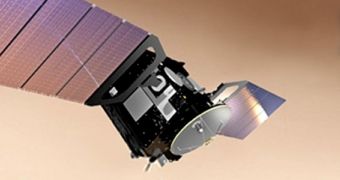Under the new space exploration agreement signed by the National Aeronautics and Space Administration (NASA) and the European Space Agency (ESA), a new spacecraft will fly to Mars in 2016. The ExoMars Trace Gas Orbiter will have a fairly straightforward mission, as it will be in charge with analyzing the chemical composition of the Red Planet's atmosphere. It will also need to be able to detect some of the rarest constituents inside it, so that researchers gain enough knowledge to explain some of the most peculiar events taking place on Mars. NASA and ESA are now turning to the international scientific community, for proposals on instruments to be outfitted on the orbiter.
One of the primary targets for ExoMars is the greenhouse gas methane. Back on Earth, it is mostly produced by decomposing organic matter. Some planetary scientists have proposed that, in the case of Mars, the detected amount of methane could be a clear indicator that basic lifeforms once lived on or neighboring planet. Previous studies of the atmosphere have determined that certain regions on the Red Planet have higher concentrations of methane than others, and a satisfactory explanation for these differences has yet to be produced. The ExoMars mission aside, establishing if Mars had life on it in the past, or if it still does today, is one of the main goals in space exploration.
In an Announcement of Opportunity that NASA and ESA released today, these agencies invite scientists from around the world to propose instrumentation for the upcoming mission. Under the terms of the agreement, the TGO will be built in Europe by ESA, and will be launched from the United States, aboard a NASA rocket. The AO states that, once all proposals are centralized, a number of ideas will be selected for actual implementation. From that point on, the teams that made the proposals will be tasked with building the actual hardware, AlphaGalileo reports
“We are open to all instrumental proposals so long as they help us achieve our scientific objectives,” says the ESA ExoMars Project Scientist, Jorge Vago. “The methane is the anchor point around which the science is to be constructed.” The gas has had a relatively short history on the Red Planet, in the sense that human-built machines only detected it in 2003. Since then, numerous questions have been posed as to what its origins are, and the only way to settle the debate is to actually go out there, and establish its main, most likely sources. Another main goal of the mission is to determine why the methane found at three Martian locations disappears at a rate several times faster than natural.

 14 DAY TRIAL //
14 DAY TRIAL //